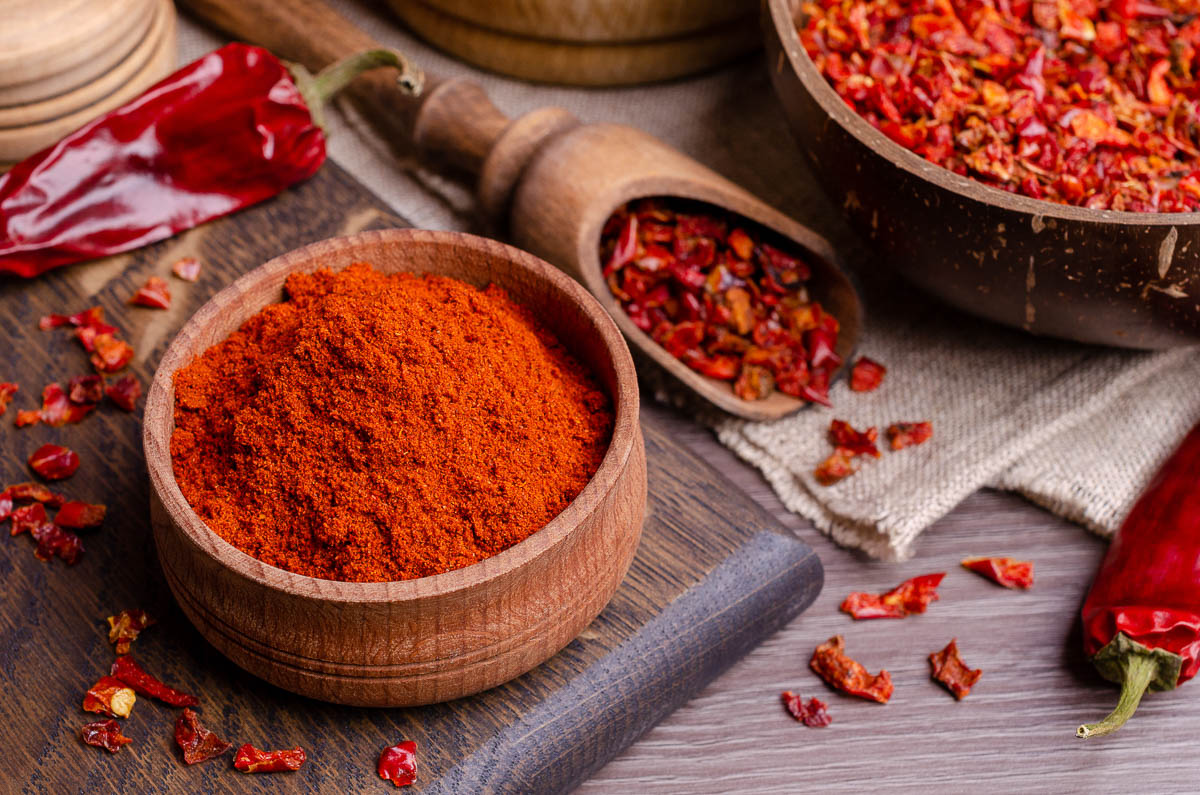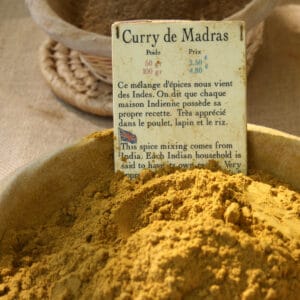If you are making a recipe that calls for cumin and you don't have any, you're going to need a replacement that will work!
It is a very unique spice with an unmistakable flavor, so you may not know what to use in its place. Once you understand what cumin is and how its used, one of the recommendations below should be a good substitute that will taste right in your recipe.
Hopefully you already have a cumin replacement on your spice rack!

Cumin Information
Origin
Cumin is a spice with a long and storied history. Originating in the Mediterranean, it has been used for millennia in both sweet and savory dishes.
The plant that cumin comes from is a member of the Apiaceae family which also includes parsley, celery, and carrots. Its scientific name is cuminum cyminum.
Taste and Flavor
Cumin's small, dark seeds are harvested and dried for use as a spice. It has a strong, warm, earthy flavor with hints of lemon. Ground cumin, or cumin powder, is commonly used because the flavor is more easily distributed throughout the entire mixture.
Heath Benefits
In addition to its culinary uses, cumin has also been traditionally used for its health benefits.
For example, cumin has been shown to boost the immune system, aid in digestion, and even help to prevent cancer. Additionally, cumin is a good source of iron and other minerals, making it an excellent addition to any diet.
Whether you're sprinkling it on your food or taking it as a supplement, there are plenty of good reasons to add cumin to your diet!

How Cumin Is Used in Different Recipes
Although cumin can be found worldwide, it is most commonly found in Indian, Middle Eastern, and American recipes.
Indian cuisine
When used in Indian cuisine, it is commonly added to curries and rice dishes. It can also be used to flavor meat and vegetables or added to soups and stews for extra depth of flavor.

Middle Eastern cuisines
Cumin is a spice that originates from the Middle East and is commonly used in Middle Eastern cuisines. It has a strong, earthy taste and is typically used to flavor meat dishes.
It is also an essential ingredient in many Middle Eastern dishes, such as hummus, falafel, and tabouli. Cumin can be used whole or ground and is often used in conjunction with other spices like chili powder, paprika, and coriander.
When used in cooking, cumin can help to create a rich and flavorful dish.

American cuisine
Cumin has become increasingly popular in American cuisine. It can be used to add flavor to a wide variety of recipes, including soups, stews, grilled meats, and vegetables.
When used sparingly, cumin can add a subtle depth of flavor to a dish. However, it can also be used as a bold flavor accent, and adds an exotic touch to recipes.

Best Cumin Substitutes
Each of the recommendations below offer a different flavor profile. Some may work better than others depending on the recipe.
Fenugreek Seeds
Fenugreek seeds are the small, hard seeds of the fenugreek plant. The plant is native to the Mediterranean region, and the seeds have a sweet, nutty flavor.
They are often used in Middle Eastern and Indian dishes, and they can be a good alternative for cumin. Fenugreek seeds are often used in curries, stews, and rice dishes.
Additionally, they can also be roasted and ground into a powder that can be used as a spice rub or added to soups and stews. Ground fenugreek powder is also a common ingredient in some commercial curry powders.

Coriander
Both Coriander Powder and Coriander Seeds are both a good cumin substitute. Coriander seeds come from the cilantro plant, which is a member of the parsley family.
The seeds have a mild, lemony flavor and are often used in Indian and Middle Eastern cuisine.
Curries, spice rubs, and soup recipes often call for coriander powder, which is simply ground up seeds. The powder can also be used as a cumin substitute in certain dishes.
When used fresh, coriander leaves have a bright, citrusy flavor that is commonly used in salads, salsa, and guacamole.
So whether you're looking to add some depth of flavor to your recipes or simply wanting to experiment with fresh herbs, coriander is a versatile option to keep in mind.

Fennel Seeds
Fennel is a member of the carrot family and its seeds are used as a spice. They have a sweet, anise-like flavor and can be used in a variety of recipes, from stews and soups to breads and cakes.
Fennel seeds can also be used as a substitute for cumin in many dishes. When grinded, fennel seeds release their essential oils and become more potent, so it is best to use them sparingly.
To get the most flavor out of fennel seeds, toast them lightly before using. This will release their aroma and make them more fragrant. Fennel seeds can be commonly found at the grocery store, either in the spice aisle or the bulk section.

Caraway Seeds
Caraway seeds come from a plant in the Apiaceae family, which also includes celery, carrots, and dill. The plant is native to Europe and Asia, and has been cultivated for thousands of years.
Both caraway seeds and ground caraway have a pungent, earthy flavor and are often used in savory dishes. They are a common ingredient in rye bread and sauerkraut, and can also be used to flavor soups, stews, and vegetable dishes.
In addition, caraway seeds can be used as a substitute for cumin. Use an equal amount of caraway seeds when substituting them for cumin.

Taco Seasoning
Taco seasoning is a blend of spices typically used to season the meat in tacos. The exact ingredients vary depending on the recipe, but common spices include chili powder, cumin, garlic powder, and paprika. These spices are combined to create a flavor that is simultaneously earthy, spicy, and slightly sweet.
In addition to tacos, taco seasoning can also be used in other Tex-Mex dishes such as enchiladas, burritos, and quesadillas.
Because cumin is a common ingredient in taco seasoning, it can be a great substitute in certain recipes.
Whether you use it in its traditional form or get creative with your cooking, taco seasoning is a versatile spice blend that is sure to add some flair to your meal.

Chili Powder
Chili powder is a potent blend of dried chili peppers, spices, and herbs. Its exact composition varies depending on the brand, but the spices and herbs typically include smoked paprika, cumin, oregano, and garlic powder.
As a result, chili powder has a complex flavor that is both fiery and earthy. It is commonly used in Tex-Mex and Indian dishes, and it can be added to soups, stews, sauces, chili recipes, and rubs for grilled meats.
When used judiciously, chili powder can give recipes a flavorful kick. However, it should be used with caution, as too much can easily overwhelm other ingredients.
Additionally, because chili powder often contains cumin, it can sometimes be used as a substitute for cumin in many recipes. When substituting chili powder for cumin, use half as much chili powder as you would cumin, as chili powder is more potent and can offer a spicy flavor.
With these tips in mind, you can experiment with using chili powder to add some heat to your favorite dishes.

Garam Masala
Garam masala is a popular spice blend used in Indian cuisine. It typically contains a mix of ground spices, such as cumin, coriander, cardamom, cloves, and pepper. The exact ingredients and proportions vary depending on the region and the cook's preference.
The spices are usually roasted to release their flavor and then ground into a powder. Garam masala has a warm, earthy flavor that can be used to enhance both vegetarian and meat dishes. It is often added at the end of cooking, but it can also be used as a dry rub or added to marinades.
Because it contains cumin, garam masala can be used as a substitute for cumin in many recipes. However, it should be used sparingly, as it has a more potent flavor.

Curry Powder
Curry powder is a blend of earthy spices that is typically used in Indian cooking. The exact ingredients vary depending on the region and the cook, but curry powder often includes turmeric, cumin, coriander, cloves, and pepper.
The spices are mixed together and then ground into a powder.
Curry powder has a warm flavor with a hint of sweetness.
It is commonly used in stews, curries, and rice dishes. When used sparingly, it can also be a good substitute for cumin in other recipes.
Whether you're trying out a new recipe or cooking your favorite dish, curry powder is a versatile spice that can add flavor and depth to any meal.

Chipotle Powder
Chipotle powder is made from dried, smoked chipotle peppers. It has a deep, smoky flavor with a hint of sweetness and heat.
This spice blend is often used in Mexican recipes, particularly to season meat dishes. It can also be used as a substitute for cumin in any recipe. When substitution, use half the amount of chipotle powder as you would cumin.

Panch Phoron (Indian Five Spice Blend)
This spice blend of whole seeds consists of cumin, fenugreek, fennel, black mustard, nigella and more.
You should be able to find this blend at Indian specialty grocery stores. Otherwise, you can make it yourself. Whole cumin seeds, fennel seeds, and many of the other seeds you will need can usually be found in the bulk spice area at most grocery stores.
Panch Phoron can be transformed from a whole seed mixture to a powder by using a spice grinder or a coffee grinder.
This blend of spices makes a great cumin substitute, especially in dishes like an Indian Curry, because of the amount of cumin in the mixture.

Anise Seeds
Anise seeds come from the perennial flowering plant known scientifically as Pimpinella anisum. This herb is native to the Mediterranean region and has been cultivated for centuries in many parts of the world.
Anise seeds have a characteristic licorice flavor that can be used to add sweetness and depth to both savory and sweet dishes. In European cooking, they are often used in baked goods such as biscuits and cakes. T
hey are also a common ingredient in Syrian and Middle Eastern dishes such as hummus and falafel.
When used in small quantities, anise seeds can be a good replacement for cumin in Indian and Mexican food.

Paprika
Paprika is a type of chili pepper that is typically used as a spice or seasoning and is known for its reddish hue. It can vary in taste from mild to hot, depending on the variety of chili pepper used.
Various types of paprika is commonly used in Hungarian, Spanish, and Portuguese cuisine. It is often used as a seasoning for meats and stews, or as a garnish for soups and salads.
Paprika can also be used as a substitute for cumin in some recipes.

Do you have any other tried and true substitution recommendations? Please let me know in the comments!






Leave a Reply